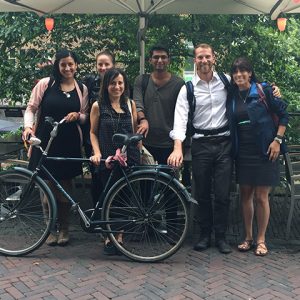August 4, 2017
 Affiliated graduate students, Maria del Mar Mancha-Cisneros and Ute Brady, attended the 16th Biennial Conference of the International Association for the Study of the Commons (IASC) to develop a set of standard variables for social-ecological systems (SES) that facilitates more effective and sustainable conservation outcomes.
Affiliated graduate students, Maria del Mar Mancha-Cisneros and Ute Brady, attended the 16th Biennial Conference of the International Association for the Study of the Commons (IASC) to develop a set of standard variables for social-ecological systems (SES) that facilitates more effective and sustainable conservation outcomes.
The conference took place in July 2017 in Utrecht, the Netherlands. Mancha-Cisneros and Brady organized the interdisciplinary panel as part of a collaboration between the ASU Center for Biodiversity Outcomes (CBO) and the Center for Behavior, Institutions, and the Environment (CBIE).
Collaborators included CBIE affiliated graduate students, Sechindra Vallury, Cathy Rubiños, Madeline Tyson, Hoon Shin, and former ASU post-doc Michael Bernstein, as well as other emerging social and natural science scholars from various U.S., Canadian, and European universities.
With CBO funding support, the team was able to present their research in a panel entitled “Breaking the Code: Synthesizing Coding Efforts for Social Ecological Systems Research.”
Panel presentations outlined issues such as defining success in resource management (success for what and for whom?); dialogues between coding variables and frameworks in case studies of Common-pool Resources; the lack of inclusion of variables deemed to be important for SES analysis in resource database; and overcoming barriers for ‘commons’ scholars to share their data and research findings in a more consistent and easily accessible manner.
The panel presentation also included suggestions as to how some of the identified problems related to SES governance may be addressed. Specifically, the CBO-CBIE research team reported on its mapping project of Elinor Ostrom’s original common pool resource variables.
These variables were incorporated into the structure of the Robustness Framework and are now publicly accessible at a Wikisite that functions both as a portal for scholars interested in learning about common pool resource (CPR) methodologies and a forum for feedback on these variables.
In doing so, the team aims to advance a common set of variables for SES analysis to foster better cross-comparisons of case studies involving natural resources and biodiversity preservation efforts.
The panel presentation was well attended and generated many interesting discussions with the potential for future collaborations. The team’s research efforts will certainly expand beyond their successful presentation at the IASC. Future collaborations between CBO, CBIE, and the Gerber Lab team are expected during the fall semester, as the coding team will continue their work broadening the interdisciplinary examination of complex coupled SES.

